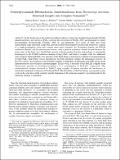| dc.contributor.author | Morar, Mariya | |
| dc.contributor.author | Hoskins, Aaron A. | |
| dc.contributor.author | Stubbe, JoAnne | |
| dc.contributor.author | Ealick, Steven E. | |
| dc.date.accessioned | 2012-07-24T18:12:28Z | |
| dc.date.available | 2012-07-24T18:12:28Z | |
| dc.date.issued | 2008-07 | |
| dc.identifier.issn | 0006-2960 | |
| dc.identifier.issn | 1520-4995 | |
| dc.identifier.uri | http://hdl.handle.net/1721.1/71787 | |
| dc.description.abstract | In the fourth step of the purine biosynthetic pathway, formyl glycinamide ribonucleotide (FGAR) amidotransferase, also known as PurL, catalyzes the conversion of FGAR, ATP, and glutamine to formyl glycinamidine ribonucleotide (FGAM), ADP, P[subscript i], and glutamate. Two forms of PurL have been characterized, large and small. Large PurL, present in most Gram-negative bacteria and eukaryotes, consists of a single polypeptide chain and contains three major domains: the N-terminal domain, the FGAM synthetase domain, and the glutaminase domain, with a putative ammonia channel located between the active sites of the latter two. Small PurL, present in Gram-positive bacteria and archaea, is structurally homologous to the FGAM synthetase domain of large PurL, and forms a complex with two additional gene products, PurQ and PurS. The structure of the PurS dimer is homologous with the N-terminal domain of large PurL, while PurQ, whose structure has not been reported, contains the glutaminase activity. In Bacillus subtilis, the formation of the PurLQS complex is dependent on glutamine and ADP and has been demonstrated by size-exclusion chromatography. In this work, a structure of the PurLQS complex from Thermotoga maritima is described revealing a 2:1:1 stoichiometry of PurS:Q:L, respectively. The conformational changes observed in TmPurL upon complex formation elucidate the mechanism of metabolite-mediated recruitment of PurQ and PurS. The flexibility of the PurS dimer is proposed to play a role in the activation of the complex and the formation of the ammonia channel. A potential path for the ammonia channel is identified. | en_US |
| dc.description.sponsorship | National Institutes of Health (U.S.) (Grant no. GM32191) | en_US |
| dc.language.iso | en_US | |
| dc.publisher | American Chemical Society (ACS) | en_US |
| dc.relation.isversionof | http://dx.doi.org/10.1021/bi800329p | en_US |
| dc.rights | Article is made available in accordance with the publisher's policy and may be subject to US copyright law. Please refer to the publisher's site for terms of use. | en_US |
| dc.source | ACS | en_US |
| dc.title | Formylglycinamide Ribonucleotide Amidotransferase from Thermotoga maritima: Structural Insights into Complex Formation | en_US |
| dc.type | Article | en_US |
| dc.identifier.citation | Morar, Mariya et al. “Formylglycinamide Ribonucleotide Amidotransferase from Thermotoga Maritima: Structural Insights into Complex Formation.” Biochemistry 47.30 (2008): 7816–7830. Copyright © 2008 American Chemical Society | en_US |
| dc.contributor.department | Massachusetts Institute of Technology. Department of Biology | en_US |
| dc.contributor.department | Massachusetts Institute of Technology. Department of Chemistry | en_US |
| dc.contributor.approver | Stubbe, JoAnne | |
| dc.contributor.mitauthor | Stubbe, JoAnne | |
| dc.relation.journal | Biochemistry | en_US |
| dc.eprint.version | Final published version | en_US |
| dc.type.uri | http://purl.org/eprint/type/JournalArticle | en_US |
| eprint.status | http://purl.org/eprint/status/PeerReviewed | en_US |
| dspace.orderedauthors | Morar, Mariya; Hoskins, Aaron A.; Stubbe, JoAnne; Ealick, Steven E. | en |
| dc.identifier.orcid | https://orcid.org/0000-0001-8076-4489 | |
| mit.license | PUBLISHER_POLICY | en_US |
| mit.metadata.status | Complete | |
